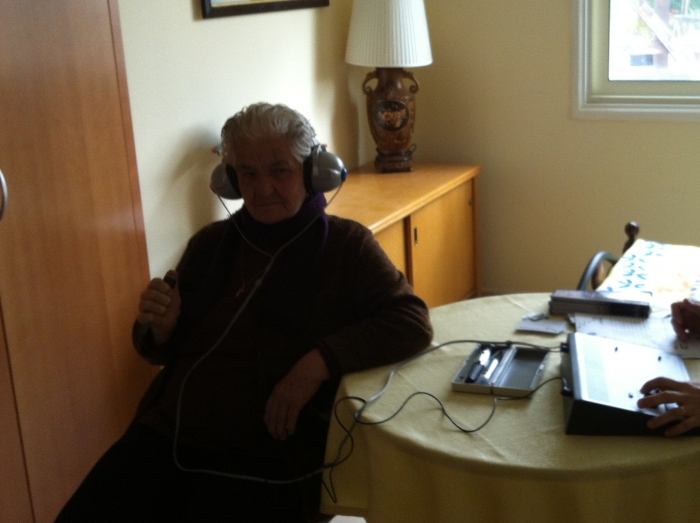Dr. Chryssoula Thodi, Audiologist; PhD, CCC-A, FAAA; Associate Professor, European University Cyprus
Correspondence: [email protected], or 22769971
Background
Hearing loss is the third most common condition affecting adults over 65 years (Cruickshanks et.al, 1998). It impacts quality of life, limiting the ability to communicate efficiently, and leads to isolation, psychological strain, functional and cognitive decline, (LaForge, Spector, & Sternberg, 1992; Lin, 2011; Yueh, Shapiro, MacLean, & Shekelle, 2003). Communication limitations caused by hearing loss impinge on the person, their family, friends, and social circle. Reports on hearing loss among adults indicate that less than 25% of people who can benefit from amplification of sound are using hearing aids. There is a 7-10 year delay between identification of hearing loss and hearing aid treatment (Kochkin, 1997, Davis, 1995, Davis, Smith, Ferguson, Stephens, & Gianopoulos, 2007), with the average age for acquiring a hearing aid around 70 years (Kochkin et al., 2010). Adult hearing screening programs might have a positive effect on raising public awareness of hearing loss and its implications, and shortening delay time for intervention. The program ΑΠΑΣ- EVERYONE- Greek acronym for Screening- Intervention-Hearing-Participation took place in 2008-2011, aiming to report adult hearing and follow up data for Cyprus.
Methods
Pensioner organization and municipality activity center members were invited via newsletters and poster announcements to participate in the hearing screening. Participants filled out a demographic/short medical history form and responded to a five-item questionnaire modified from the Hearing Handicap Inventory for the Elderly (HHIE-Screening Version, Weinstein, 1986). In an effort to shorten screening time and bring cultural relevance to the questions, five items were dropped from the initial questionnaire and the remaining 5 questions modified. The list included questions on whether a hearing difficulty causes frustration when talking to family-Q1, difficulty hearing when someone whispers-Q2, complaints from family members-Q3, difficulty listening to TV or radio-Q4, and difficulty communicating when in a restaurant or coffeehouse-Q5. Responses to the questions were coded with 0-never, 1-sometimes, 2-often, making the maximum possible score on the questionnaire a 10. Participants responded yes or no to the informal question “do you believe that you have a hearing loss”, in an effort to increase testing sensitivity (Gates, Murphy, Rees, & Fraher, 2003), and participant sensitization.
Testing included otoscopy and air conduction pure tone audiometry at 250-4000Hz, according to Carhart and Jerger, (1959). Referrals based on otoscopy, unilateral findings, and/or on PTA (1-2-4kHz> 35dBHL in the worse ear) were made for medical and/or audiological evaluation. When a referral was made for a hearing aid evaluation a short explanation of the findings was accompanied by recommendations for improving speechreading, sitting arrangements in noisy situations, and acknowledgment of hearing difficulty to the communication partners.
Structured telephone interviews were conducted 1-2 years later with 160 of the referred participants, based on a Compliance Questionnaire. Questions addressed whether the person had followed the recommendation for medical/audiology/hearing aid evaluation, trial and use of hearing aids, awareness of the hearing loss, information seeking post-screening, and attitudes toward the screening process.
Results
A total of 3025 adults were evaluated, aged 55-92 years, average age 78 years. The referral rate was 46%, which included participants referred for cerumen removal/medical evaluation (17%), and participants referred for hearing/hearing aid evaluation (46%). An additional 12% of the subjects had pure tone averages within 5dB below the referring criteria (16% of participants under 70 were “just below referral”, compared to 12% in people 70-80 years, and 0% above 80 years). Pure tone averages of the people screened in each age group showed the following mean value distribution: 34 dBHL for 161 people under 60 years; 38dBHL for 856 subjects 60-70 years; 45dBHL for 1491 subjects 71-80 years; 54 dBHL for 517 subjects older than 80 years of age. Overall results of the program are shown in Fig. 1.
Figure 1. Hearing Screening results
Total questionnaire response scores and positive responses to the universal question “do you believe that you have a hearing loss” increased with advancing age, indicating an increase in communication difficulties and family complaints. The total questionnaire score correlated well with both 1-2kHz, and 1-2-4kHz PTA in the worse ear (r2=0.51 for both PTAs). Family complaints about the person’s hearing loss correlated highest with 1-2kHzPTA>35dBHL (r2=0.48). Based on the referral criterion, the informal question showed a sensitivity of 67%, and a specificity of 76%. If a person obtained a total score of 3 or more on the screening questionnaire, the sensitivity of a referral when compared to the criterion would be 69% and the specificity 73.9%.
Over 92% of the people referred reported compliance with the recommendations. However, the answer to whether they received a hearing evaluation based on the referral may have been confounded by inclusion of the screening process in their response. Of the people referred for a hearing/hearing aid evaluation, 18% reported having tried a hearing aid; 11% reported using a hearing aid at the time of the interview, indicating that 39% of those who tried hearing aids decided against using amplification. This is an important finding, possibly indicating a need to investigate reasons for low uptake of amplification as they relate to the overall quality and cost of hearing amplification services in Cyprus.
Among hearing aid users, 22% were very satisfied with their device, 28% satisfied, 11% were not satisfied, and 39% declined to respond. The majority of referred participants (80%) reported that they knew they had a hearing loss before confirmation from the screening. Very few people sought information about hearing and interventions after the screening (20%), but 82% reported discussing the results with their family. Despite the low compliance rate with hearing aid use, 95% of participants reported that the process helped them, they would participate in similar tests in the future, and that the test should be offered to all.

Discussion
The Cyprus pilot adult hearing screening program assessed the hearing of socially community-dwelling older retirees who volunteered participation, in a first attempt to collect data for hearing loss in Cyprus. Referral rates were higher than those in population studies reported in the literature (Davis, 1989; Davis, 1990). The high referral rate and the percentage of subjects just below the referral criteria may support the notion that initial communication difficulties motivated participation in the program. This might be the first instance of “seeking help” (Kiessling et al., 2003): participants who had an initial identification of a mild hearing loss through this program might be ready to accept help when hearing difficulties reach a critical point.
Subjects had positive reactions and seemed to open up with responses to the short questionnaire, which might have served as a validation of perceived difficulties. Questions presenting specific situations or identifying family reactions may be a first step towards removing some barriers to help seeking (awareness of the problem, negative attitudes of significant others, lack of knowledge, Kochkin et al., 2010). Sensitivity and specificity features of the modified version of the HHIE-S were consistent with those in the literature (Lichtenstein, Bess, & Logan, 1988), making it a useful tool to be recommended to medical professionals.
Based on the high referral rates which showed a population with increased need to seek help, the rate of hearing aid trial and uptake was very low. Kochkin (2007) indicated several factors: perception of hearing aid disadvantages, cost, and lack of trust in the professional recommending amplification. Wallhagen (2010) reported stigmatization of hearing loss among older adults, with indications of associating hearing aid use with lower cognitive function, advanced age, and disability. The stigma seemed to be reinforced by negative attitudes by professionals and partners, as well as the emphasis on discreet appearance placed by the hearing aid industry (Wallhagen, 2010). Meyer and Hickson (2012) in a comprehensive review of factors affecting help-seeking and hearing aid adoption emphasized the need for general practitioners to refer to audiology for hearing assessment and intervention. Hearing aids are not subsidized in Cyprus, making cost a major factor in hearing aid adoption by this population, followed by expectations and benefit of hearing aid use, with only half the people using hearing aids reporting any level of satisfaction.
Quality of life in adults with hearing loss can be improved with appropriate intervention. Emotional, communication, and cognitive function, as well as depression scores improved after hearing aid fitting (Mulrow et al., 1990). The need to increase early detection of adult hearing loss was further emphasized by economic advantages found by Morris, Lutman, Cook, and Turner (2012): they reported that screening is more cost effective than referral by the General Practitioner, and recommended a pilot of hearing screening at 60, 65, and 70 years of age.
The tendency for people under 70 with marginal hearing loss to seek assessment indicates that increased awareness provided by well publicized screening programs and availability of assessment opportunities may eventually result in more people seeking support earlier for hearing difficulties. Considering the time delay between first validation of perceived difficulty by professional verification of hearing loss and adoption of hearing aids, it remains to be seen if the group of people who participated in the study will adopt intervention earlier than predicted by existing reports. Timely screening for hearing loss and communication difficulty, and preliminary counseling may be the first step toward this goal. Further outcome measures are needed to investigate the impact of this screening program and sustainability of results. As the primary care physician is older adults’ main health service provider, sensitization to early signs and timely referral for hearing evaluation and amplification might significantly improve quality of life in older adults.
Acknowledgments
This program was implemented by Cyprus Audiology Center, funded by the European project “AHEAD III: Assessment of Hearing in the Elderly: Aging and Degeneration – Integration through Immediate Intervention”. FP7, contract HEALTH-F2-2008-20083, 2008-2011.







